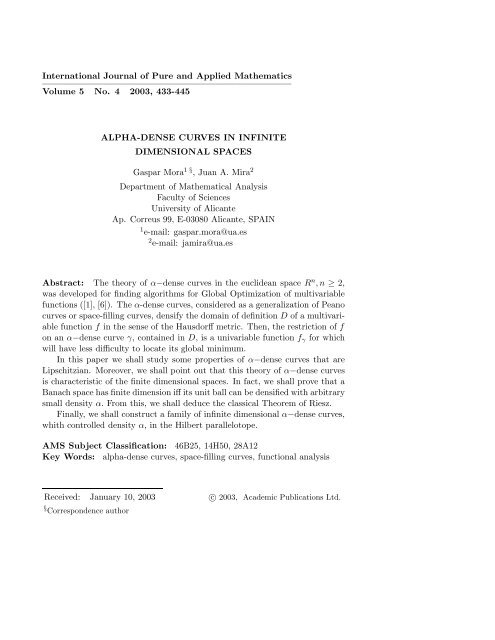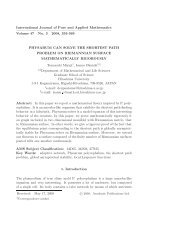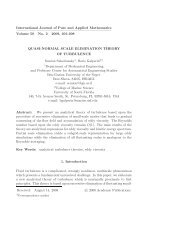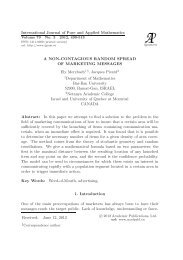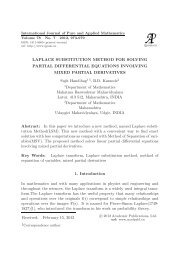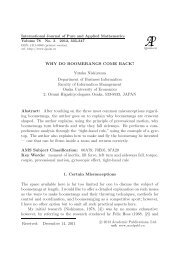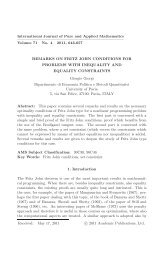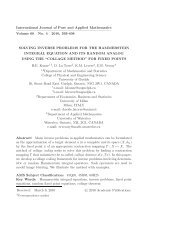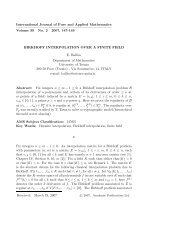ALPHA-DENSE CURVES IN INFINITE DIMENSIONAL SPACES
ALPHA-DENSE CURVES IN INFINITE DIMENSIONAL SPACES
ALPHA-DENSE CURVES IN INFINITE DIMENSIONAL SPACES
You also want an ePaper? Increase the reach of your titles
YUMPU automatically turns print PDFs into web optimized ePapers that Google loves.
International Journal of Pure and Applied Mathematics<br />
————————————————————————–<br />
Volume 5 No. 4 2003, 433-445<br />
<strong>ALPHA</strong>-<strong>DENSE</strong> <strong>CURVES</strong> <strong>IN</strong> <strong>IN</strong>F<strong>IN</strong>ITE<br />
<strong>DIMENSIONAL</strong> <strong>SPACES</strong><br />
Gaspar Mora 1 § , Juan A. Mira 2<br />
Department of Mathematical Analysis<br />
Faculty of Sciences<br />
University of Alicante<br />
Ap. Correus 99, E-03080 Alicante, SPA<strong>IN</strong><br />
1 e-mail: gaspar.mora@ua.es<br />
2 e-mail: jamira@ua.es<br />
Abstract: The theory of α−dense curves in the euclidean space R n ,n ≥ 2,<br />
was developed for finding algorithms for Global Optimization of multivariable<br />
functions ([1], [6]). The α-dense curves, considered as a generalization of Peano<br />
curves or space-filling curves, densify the domain of definition D of a multivariable<br />
function f in the sense of the Hausdorff metric. Then, the restriction of f<br />
on an α−dense curve γ, contained in D, is a univariable function fγ for which<br />
will have less difficulty to locate its global minimum.<br />
In this paper we shall study some properties of α−dense curves that are<br />
Lipschitzian. Moreover, we shall point out that this theory of α−dense curves<br />
is characteristic of the finite dimensional spaces. In fact, we shall prove that a<br />
Banach space has finite dimension iff its unit ball can be densified with arbitrary<br />
small density α. From this, we shall deduce the classical Theorem of Riesz.<br />
Finally, we shall construct a family of infinite dimensional α−dense curves,<br />
whith controlled density α, in the Hilbert parallelotope.<br />
AMS Subject Classification: 46B25, 14H50, 28A12<br />
Key Words: alpha-dense curves, space-filling curves, functional analysis<br />
Received: January 10, 2003 c○ 2003, Academic Publications Ltd.<br />
§ Correspondence author
434 G. Mora, J.A. Mira<br />
1. Introduction and Notation<br />
When we try to find the global minimum of a real continuous function f defined<br />
on a compact set, say a parallelepiped D = ⊓ n i=1 [ai,bi] of R n with n ≥ 2,<br />
many problems, closely connected with the location of that critical point, occur.<br />
These difficulties should be, certainly, less if the objetive function f were<br />
univariable.<br />
Assume that, for arbitrary small α > 0, there exists a curve γα : I = [0,1] →<br />
R n , satisfying the conditions:<br />
i) γ ∗ α = γα(I) ⊂ D.<br />
ii) for any x ∈ D, the distance . (1)<br />
Thus, the restriction fγα of f on γ ∗ α is an approximant to f in the sense that<br />
the Hausdorff distance dH( γ ∗ α,D) tends to 0 as α does (see [2, p. 61]). Now, by<br />
continuity the minimization of f can be substituted by the minimization of fγα<br />
and so the global minimum of fγα is taken as an approximation to the global<br />
minimum of f (see [1], [5], [6], [12]).<br />
For a given α > 0, a curve γα, for which the above conditions (1) are fulfilled,<br />
is said to be α − dense in D or that the curve γα densifies D with density α.<br />
In a general metric space (E,d) a compact set K, containing α-dense curves<br />
with arbitrary small α > 0, is called densifiable (see [5] and [12], for more<br />
details). For instance, in R n all parallelepipeds are densifiable sets and, in fact,<br />
the α-dense curves densifying them can be chosen of class C ∞ (see [5], [12]).<br />
As, in practice, many functions to minimize are Lipschitzian, it is convenient<br />
to take the α-dense curves to be also Lipschitzian. We recall that a function<br />
g : I → E is said to be Lipschitzian of exponent 0 < β ≤ 1 iff there exists a<br />
constant l > 0 such that (for properties see, for instance, [13])<br />
d(g(t),g(t ′ )) ≤ l � � t − t ′ � � β . (2)<br />
In [7] is proposed the problem of the existence of a minimal length curve<br />
densifying the unit square I 2 with fixed density α > 0. Nevertheless, [11] deals<br />
with the same question but in a compact set K belonging to a general metric<br />
space. The solution of this problem is given by considering the set Λα,l(K)<br />
of all Lipschitzian α-dense curves in K, with constant l and exponent β = 1.<br />
Since there is a connection between the degree of density α and the constant<br />
of Lipschitz l, in the present article we shall determine a lower bound of l to<br />
guarantee that the set Λα,l(K) is non-void.<br />
On the other hand, we shall prove that the degree of densification of the<br />
unit ball of a normed space determines its dimensionality (see the Theorem).
<strong>ALPHA</strong>-<strong>DENSE</strong> <strong>CURVES</strong> <strong>IN</strong> <strong>IN</strong>F<strong>IN</strong>ITE... 435<br />
We shall use this idea to show that any curve in the unit ball of an infinite<br />
dimensional normed space densifies it with the worst of all densities, namely<br />
α ≥ 1. By virtue of this theorem we shall obtain, as corollary, the well-known<br />
Theorem of Riesz on the finite dimensionalty of locally compact normed spaces<br />
(see for instance [2], [4], [10]).<br />
Also we shall construct a family of infinite dimensional curves, with arbitrary<br />
density α, in the Hilbert parallelotope. The method that we shall exhibit<br />
here is different to that of Schöenberg curve that, recall, fills K, whereas our<br />
curves densify it with controlled density (see [ 8, p. 128]). The goal consists of<br />
using none Cantor set to define the curve, as that of [8] . Our construction is a<br />
natural generalization of the method for densifying finite dimensional domains<br />
exhibed in [5].<br />
2. Lipschitzian α-dense Curves<br />
In this section we point out the relation between the degree of density α and the<br />
constant l in such a way that Λα,l(K) to be a non-empty set. For this purpose,<br />
we begin to expose a simple example, where Λα,l(K) = ∅ for certain values of<br />
α and l.<br />
Example 1. In R2 the segment line K = {(x,0) : 0 ≤ x ≤ 1} is a<br />
densifiable set for which Λα,l(K) = ∅, for any 0 < α < 1 1<br />
and 0 < l ≤<br />
4 2 .<br />
and<br />
Proof. Suppose that there exists some f ∈ Λα,l(K). Thus,<br />
i) f : I → K is continuous and has density α in K<br />
ii)�f(t) − f(t ′ )� ≤ l |t − t ′ | for any t,t ′ ∈ I.<br />
From i), there exists a continuous function ϕ : I → I such that f(t) =<br />
(ϕ(t),0) for t ∈ I. Let t0,t1 be the values, where ϕ attains the global extrema,<br />
minimum and maximum respectively. Because of the α−density, ϕ(t0) ≤ α and<br />
ϕ(t1) ≥ 1 − α.<br />
Therefore<br />
ϕ(t1) − ϕ(t0) ≥ 1 − 2α. (1)<br />
By the condition ii),<br />
|ϕ(t1) − ϕ(t0)| ≤ l |t1 − t0| ≤ l
436 G. Mora, J.A. Mira<br />
and from (1), 1 − 2α ≤ l ≤ 1 1<br />
. Thus,<br />
2 4<br />
α < 1<br />
4 .<br />
≤ α, which is a contradiction since<br />
As a first approximation to establish the dependance of α we include this<br />
easy result.<br />
Proposition 2. Let K be a compact densifiable set in a metric space<br />
(E,d). For α sufficiently small, if Λα,l(K) �= ∅, then, necessarily l ≥ ∆ − 2α,<br />
where ∆ denotes the diameter of K.<br />
For the sake of completeness we give the next trivial lemma.<br />
Lemma 3. Let (E,d) be a metric space. Any curve γ : I → E, satisfying<br />
the Lipschitz condition of constant l and exponent β = 1, is rectifiable and its<br />
length Lγ ≤ l.<br />
Fixed the densifiable compact set, a lower bound, in function of the density,<br />
for the Lipschitz constant is stated in the following theorem.<br />
Theorem 4. For 0 < α ≤ 1<br />
, any Lipschitzian α-dense curve in the unit<br />
2<br />
square I2 , of constant l and exponent β = 1, satisfies l ≥ 1<br />
− 1.<br />
2α<br />
Proof. Let m = � α−1� be the entire part of α−1 . The partition P =<br />
{0, 2<br />
� �<br />
4 m<br />
m + 1<br />
, ,..., } produces, in the unit interval I, the M = subinter-<br />
m m m 2<br />
vals<br />
�<br />
I1 = 0, 2<br />
� � �<br />
2 4<br />
�<br />
,I2 = , ,... ,IM = aM,<br />
m m m<br />
m<br />
�<br />
,<br />
m<br />
where<br />
⎧<br />
⎪⎨<br />
m − 1<br />
m<br />
aM =<br />
⎪⎩ m − 2<br />
m<br />
if m is odd,<br />
if m is even.<br />
Thus, the square is divided in M strips I1 × I, I2 × I, ..., IM × I having<br />
each 2m −1 in width. Since for densifying each strip is needed at least a segment<br />
line (actually the mean line) of length 1, any curve of density less or equal than<br />
m −1 in the square will have, at least, M of length. Now, noticing the definitions<br />
of m and M we have<br />
M > m<br />
2<br />
1 1<br />
− > − 1.<br />
2 2α
<strong>ALPHA</strong>-<strong>DENSE</strong> <strong>CURVES</strong> <strong>IN</strong> <strong>IN</strong>F<strong>IN</strong>ITE... 437<br />
Therefore the length Lγ of any α−dense curve in the unit square verifies<br />
Lγ ≥ M > 1<br />
− 1.<br />
2α<br />
Now, by applying the above lemma, the proof is completed.<br />
Remark 5. We have omitted, in our study, the case 0 < β < 1. The reason<br />
consists of that it could lead to obtain curves, whose graphs have nonzero<br />
Lebesgue measure. Indeed, a lemma of [9] proves that the image of a Lipschitzian<br />
function f : R → Rn of exponent β, with β > 1<br />
, has Lebesgue<br />
n<br />
measure zero and, of course, these curves are our subject to study.<br />
3. α-dense Curves and Dimensionality<br />
From a geometrical intuitive point of view, it appears that is always possible<br />
to put a curve, with arbitrary small density α, into the unit ball. As soon we<br />
shall see, this is a peculiar property of the finite dimensional spaces.<br />
We proceed by proving this elementary result.<br />
Lemma 6. In a metric space (E,d), any densifiable set K is precompact.<br />
ε<br />
Proof. Given ε > 0, let γ ε : I → E be a curve of density in K. Then,<br />
2 2<br />
the image γ ε<br />
, satisfies<br />
2 (I), denoted by γ∗ε 2<br />
On the other hand, γ∗ ε<br />
2<br />
exists, a finite set F ⊂ γ∗ ε<br />
2<br />
From (1) and (2)<br />
d(x,γ ∗ ε)<br />
≤<br />
2<br />
ε<br />
2<br />
for all x ∈ K. (1)<br />
is a compact set of E, so precompact. Thus, there<br />
such that<br />
d(y,F) ≤ ε<br />
2<br />
d(x,F) ≤ ε for all x ∈ K,<br />
implying that K is precompact, as claimed.<br />
for all y ∈ γ ∗ ε.<br />
(2)<br />
2<br />
With the help of the precedent lemma, we show a characterization of the<br />
finite dimension spaces by means of the densification of its unit ball.
438 G. Mora, J.A. Mira<br />
Theorem 7. A Banach space (E, ��) is finite dimensional if and only if<br />
the closed unit ball B is densifiable.<br />
Proof. Consider the unit closed ball B in the finite dimensional space R n .<br />
Then, there exists, for each ε > 0, a finite quantity of parallelepipeds Hi, with<br />
1 ≤ i ≤ p, such that:<br />
i) If Hi,Hj are adjacent, then, they have a common part of boundary but<br />
disjoint interiors.<br />
ii) ∪ p<br />
i=1 Hi ⊂ B.<br />
iii) For any x ∈ B, d(x, Hi) ≤ ε for some i = 1,2,... ,p.<br />
Since each Hi can be densified by an α-dense curve γi (see [5]), i), ii) and<br />
iii) imply that there exists an α-dense curve γ into B by considering the union<br />
of all γi (it could be added or cutted a finite quantity of pieces of each curve to<br />
define the α-dense curve in B). Hence, as ε and α are arbitrary small, the unit<br />
ball is densifiable.<br />
Reciprocally, assume the unit ball B of a Banach space (E, ��) is densifiable.<br />
Then, by the above lemma, B is precompact and, by completeness, compact.<br />
Therefore, by applying the Theorem of Riesz (see, for instance [2], [4], [10]) the<br />
space has finite dimension, and so the proof is completed.<br />
Let (E, ��) be an infinite dimensional Banach space. By the above theorem,<br />
the unit ball B is not densifiable but it will have a certain degree of densification<br />
that we are going to determine. To precise this idea we introduce the following<br />
definitions.<br />
Definition 8. Let f : I → B be an arbitrary continuous function. By<br />
compactness, for each x ∈ B, the distance<br />
δx = d(x,f(I) = inf{�x − f(t)� : t ∈ I}<br />
is attained.<br />
Since δx ≤ 2 for all x ∈ B, the number mf = sup{δx : x ∈ B} exists and<br />
satisfies mf ≤ 2. Thus mf is called the degree of density of f in B.<br />
Definition 9. Denote C(I,B) the set of all continuous functions f : I →<br />
B. Then, the number MB = inf{mf : f ∈ C(I,B) } is defined as the degree of<br />
densification of B.<br />
From the above definition, one has that MK = 0 iff K is a densifiable set.<br />
Then, in an infinite dimensional normed space, the unit ball B satisfies that<br />
MB > 0. But, can we determine a strictely positive bound for MB? Before
<strong>ALPHA</strong>-<strong>DENSE</strong> <strong>CURVES</strong> <strong>IN</strong> <strong>IN</strong>F<strong>IN</strong>ITE... 439<br />
to give the answer to this question, we begin with an example of curve, with<br />
inifinite length, which densifies the unit ball with a rough degree of density,<br />
namely greater than, or equal to 1.<br />
Example 10. Let L 2 (I) be the Hilbert space of all real functions of<br />
integrable square defined on I = [0,1]. The curve f : I → L 2 (I), defined by<br />
f(t) = ℵ [0,t] (the characteristic function of the set [0,t]), is contained in the unit<br />
ball B, has infinite length and a degree of density mf ≥ 1.<br />
Proof. Suppose t ′ > t, then, f(t ′ ) − f(t) = ℵ [t,t ′ ] and so<br />
�<br />
� f(t ′ ) − f(t) � � 2 = t ′ − t = � �t ′ − t � �. (1)<br />
Hence f is a Lipschitzian of constant 1 and exponent β = 1<br />
2 , so it is continuous<br />
on I.<br />
The length of f is<br />
Lf = sup{<br />
n�<br />
�f(ti) − f(ti−1)� : P ∈ Π}, (2)<br />
i=1<br />
where Π denotes the set of all partitions of I.<br />
Taking the partition Pn = { i<br />
n : i = 0,1,... ,n}, by (2) and (1) Lf ≥<br />
�n i=1 (1<br />
n )12<br />
= n 1<br />
2 for all n, so f has infinite length.<br />
Let g(t) = −1 be for all t ∈ I. Denote δg = inf{�g − f(t)� : t ∈ I}, i. e.<br />
the distance from g to the graph of the curve f. Noticing the inner product in<br />
L2 (I),<br />
�g − f(t)� 2 = 〈g − f(t),g − f(t)〉 = �g� 2 + �f(t)� 2 − 2 〈g,f(t)〉 ≥ 1. (3)<br />
Since g ∈ B, from (3)<br />
and the example is proved.<br />
mf = sup{δh : h ∈ B} ≥ δg ≥ 1,<br />
Remark 11. Observe that relation (1), in the above example, implies the<br />
pythagorean property<br />
�<br />
� f(t ′ ) − f(t) � � 2 + � �f(t ′′ ) − f(t ′ ) � � 2 = � �f(t ′′ ) − f(t) � � 2 for all t < t ′ < t ′′ .<br />
Therefore the vectors f(t ′ ) − f(t) and f(t ′′ ) − f(t ′ ) are orthogonal for all t <<br />
t ′ < t ′′ . This function f(t) is called a Brownian curve (see [3]).
440 G. Mora, J.A. Mira<br />
The above example is not an anomalous property of the space L 2 (I). In<br />
fact, we shall prove below that the density α of any curve in the unit ball of<br />
any infinite dimensional normed space is the worst of all, namely α ≥ 1.<br />
Theorem 12. Let (E, ��) be an infinite dimensional normed space. Thus,<br />
the degree of densification of the unit ball, MB ≥ 1.<br />
Proof. Let γ : I → E an arbitrary curve of density α in B. Then, for any<br />
x ∈ B one has<br />
inf{�x − γ(t)� : t ∈ I} ≤ α. (1)<br />
Assume α < 1. Thus, choose 0 < 2ε < 1−α. By compactness, given ε there<br />
exists a finite set F = {γ(ti) : i = 1,... ,n} such that<br />
From (1) and (2),<br />
inf{�y − γ(ti)� : i = 1,... ,n} ≤ ε for any y ∈ γ(I). (2)<br />
inf{�x − γ(ti)� : i = 1,... ,n} ≤ α + ε for any x ∈ B. (3)<br />
Define V as the subspace generated by F. Since V has finite dimension, it<br />
is closed. Therefore there exists a vector x0 ∈ E such that<br />
inf{�x0 − v� : v ∈ V } = λ ≥ 1, (4)<br />
and so we can determine a vector v0 ∈ V such that<br />
λ ≤ �x0 − v0� ≤ λ + ε. (5)<br />
Define z0 = x0 − v0<br />
�x0 − v0� and so z0 ∈ B. By applying (3), there exists 1 ≤ k ≤<br />
n such that<br />
�z0 − γ(tk)� ≤ α + ε. (6)<br />
On the other hand, we can write<br />
x0 = v0 + �x0 − v0�.γ(tk) + �x0 − v0� .(z0 − γ(tk).<br />
Since v0 + �x0 − v0� .γ(tk) ∈ V , from (4) we deduce<br />
��x0 − v0� .(z0 − γ(tk).� = �x0 − v0� . �z0 − γ(tk)� ≥ λ ≥ 1.<br />
Consequently,<br />
�x0 − v0� ≥<br />
λ<br />
�z0 − γ(tk)� ,
<strong>ALPHA</strong>-<strong>DENSE</strong> <strong>CURVES</strong> <strong>IN</strong> <strong>IN</strong>F<strong>IN</strong>ITE... 441<br />
and by using (6)<br />
�x0 − v0� ≥ λ<br />
α + ε .<br />
Now, from (5) we obtain λ+ε ≥ λ<br />
λ<br />
or equivalently ≤ α+ε. From<br />
α + ε λ + ε<br />
the choise of ε, we are led to λ ≤ 1 − ε, which contradits (4). Thus, α ≥ 1 for<br />
any arbitrary curve γ and, noticing Definition 8 and Definition 9, the degree of<br />
densification of the unit ball MB ≥ 1, and so the theorem follows.<br />
Corollary 13. (The Theorem of Riesz) Any normed space (E, ��) locally<br />
compact is finite dimensional.<br />
Proof. Without loss of generality, we can suppose that the unit ball B is<br />
compact. Assume E to be infinite dimensional, then by the above theorem<br />
MB ≥ 1. (1)<br />
Choose 0 < ε < 1, by compactness there exists a finite set<br />
F = {xi : i = 1,... ,p} ⊂ B such that B ⊂ ∪ p<br />
i=1 B(xi,ε),<br />
where B(xi,ε) denotes, as usual, the closed ball of center xi and radius ε.<br />
Consider a polygonal line L joining all centers of the balls, then, there exists a<br />
continuous function γ : I → E, whose graph is L. By construction, γ is a curve<br />
in B of density α ≤ ε. Noticing Definition 8 and Definition 9 we have mγ ≤ ε,<br />
MB ≤ ε < 1, which contradits (1) and so the result is showed.<br />
Remark 14. The Riesz Theorem establishes the finite dimensionality of<br />
the space as consequence of the compactness of the unit ball. Nevertheless,<br />
it does not say what is the size of the compacts contained in the unit ball,<br />
which it is exactly the heart of the Theorem 12. Therefore, obviously, the Riesz<br />
Theorem does not imply Theorem 12.<br />
4. Infinite Dimensional α-dense Curves<br />
In [8] we can find the construction of the Schöenberg curve as example of spacefilling<br />
curve in an infinite dimensional space. Of course any space-filling curve<br />
is, in particular, an α-dense curve, but our interest is to give a curve with<br />
controlled and strictly positive density α. Furthermore, we would like to exhibe<br />
a technique other than [8], where we recall, was used a Cantor set.
442 G. Mora, J.A. Mira<br />
Let us denote by R ω the product of countably many copies of R endowed<br />
with the metric defined by<br />
d(x,y) =<br />
∞� 1 |xn − yn|<br />
.<br />
2n 1 + |xn − yn| ,<br />
n=1<br />
with x = (xn)n=1,2,... and y = (yn)n=1,2,....<br />
From elementary considerations over the above distance, the next lemma<br />
trivially follows<br />
Lemma 15. A sequence of continuous functions Φi : I → R, with i =<br />
1,2,... , determines a continuous function Φ : I → R ω , defined by Φ(t) = (<br />
Φi(t))i=1,2,....<br />
The simplicity of the following technical result is clear.<br />
Lemma 16. Let ϕ : I → I be a continuous surjective function of period<br />
0 < τ < 1. For any interval A ⊂ I with length |A| > τ, one has A∩ ϕ −1 (B) �= ∅<br />
for all nonvoid open set B ⊂ I.<br />
For our aim, the following lemma is crucial.<br />
Lemma 17. Let n ≥ 2 be an integer and ϕ : I → I a continuous and<br />
surjective function of period 0 < τ < 1. Consider the function Φn : I → R n ,<br />
defined by Φn(t) = (Φn,i(t))i=1,...,n, where Φn,i(t) = ϕ i−1 (t) (the exponent<br />
i − 1 denotes the composition of ϕ with itself i − 1 times, and ϕ 0 the identity<br />
function). Then, Φn densifies the parallelepiped I n with density α = τ √ n.<br />
Proof. Let x = (xi)i=1,...,n be a point of I n . Let us take ε > τ and define<br />
the intervals Bi = (xi − ε,xi + ε) ∩ I for i = 1,... ,n. Since the length of B1 is<br />
greater than τ, by applying the above lemma, the set<br />
Φ −1<br />
n,1 (B1) ∩ Φ −1<br />
n,2 (B2) ∩ · · · ∩ Φ −1<br />
n,n(Bn)<br />
= B1 ∩ ϕ −1 (B2) ∩ ϕ −2 (B3) ∩ · · · ∩ ϕ −n+1 (Bn), (1)<br />
where (ϕ −2 ,ϕ −3 ,... ,ϕ −n+1 denotes the composition of ϕ −1 , with itself, 2, 3,<br />
. .., n − 1 times, will be nonvoid if<br />
ϕ −1 (B2) ∩ ϕ −2 (B3) ∩ · · · ∩ ϕ −n+1 (Bn) (2)<br />
is a nonvoid open set in I.<br />
The expression (2) can be written as<br />
ϕ −1 (B2 ∩ ϕ −1 (B3) ∩ · · · ∩ ϕ −n+2 (Bn)), (3)
<strong>ALPHA</strong>-<strong>DENSE</strong> <strong>CURVES</strong> <strong>IN</strong> <strong>IN</strong>F<strong>IN</strong>ITE... 443<br />
so, as the length of B2 is greater than τ. By using the above lemma, the set<br />
(3) will be nonvoid if<br />
ϕ −1 (B3) ∩ · · · ∩ ϕ −n+2 (Bn)<br />
is a nonvoid open set in I.<br />
Therefore, repeating this process we are led, finally, to consider the set<br />
Bn−1 ∩ ϕ −1 (Bn),<br />
which is nonvoid by the Lemma 16. Thus, the set defined by the expression<br />
(1) is nonvoid and consequently there exists t ∈ I with Φn,i(t) ∈ Bi for all<br />
i = 1,2,... ,n. This implies that<br />
Hence, the euclidean distance<br />
|Φn,i(t) − xi| < ε for all i = 1,2,... ,n.<br />
d(Φn(t),x) < ε √ n, for any ε > τ<br />
and so d(Φn(t),x) ≤ τ √ n, which proves the lemma.<br />
The construction of α-dense curves, with arbitrary α > 0, in infinite dimensional<br />
spaces is given by means of the following result.<br />
Theorem 18. The Hilbert parallelotope I w is a densifiable set in the<br />
metric space (R w ,d).<br />
Proof. Let α be a positive arbitrary real number. Given ε > 0, determine<br />
a positive integer n such that<br />
∞�<br />
i=n+1<br />
1<br />
< ε.<br />
2i Noticing the above lemma, for τ =<br />
α<br />
√ n there exists a curve<br />
Φn = (Φn,i)i=1,2,...,n densifying I n with density α. Define the function Ω :<br />
I → R w by Ω(t) = (Ωi(t))i=1,2,...withΩi(t) = Φn,i(t) for i = 1,2,... ,n and<br />
Ωi(t) = Ψi(t) for i > n, where Ψi are arbitrary continuous functions defined<br />
and valued on I. From Lemma 15, Ω is continuous, so it defines a curve in the<br />
Hilbert parallelotope.<br />
Let x = (xi)i=1,2,... be a point of I w . Let us denote Xn = (xi)i=1,2,...,n. Then,<br />
by applying Lemma 17, there exists t ∈ I such that the euclidean norm<br />
�Xn − Φn(t)� ≤ α.
444 G. Mora, J.A. Mira<br />
According to the metric defined in R ω ,<br />
d(x,Ω(t)) =<br />
∞� 1<br />
2<br />
i=1<br />
i.<br />
|xi − Ωi(t)|<br />
1 + |xi − Ωi(t)|<br />
n� 1<br />
≤<br />
2i �Xn − Φn(t)� +<br />
i=1<br />
for arbitrary ε. Therefore the theorem follows.<br />
∞�<br />
i=n+1<br />
1<br />
< α + ε,<br />
2i Remark 19. As we have just seen, Theorem 18 gives us a very large class<br />
of α-dense curves densifying the Hilbert parallelotope. This family of curves<br />
can be easily constructed, according Lemma 16. By choosing a surjective and<br />
periodical continuous function ϕ : I → I. After, the process is merely completed<br />
by taking arbitrary continuous functions Ψi : I → I from a sufficiently large<br />
positive integer n.<br />
References<br />
[1] H. Ammar, Y. Cherruault, Approximation of a several variables function<br />
by a one variable function and application to global optimization, Math.<br />
Comput. Modelling, 18, No. 2 (1993), 17-21.<br />
[2] J. Dieudonné, Fondements de L’Analyse Moderne, Tome I, Gauthier-<br />
Villars, Paris (1969).<br />
[3] J.P. Kahane et al, Leçons de Mathématiques D’aujourd’hui, Cassini, Paris<br />
(2000).<br />
[4] G. Köthe, Topological Vector Spaces I, Springer-Verlag, Berlin (1969).<br />
[5] G. Mora, Y. Cherruault, Characterization and generation of α-dense<br />
curves, Computers Math. Applic., 33, No. 9 (1997), 83-91.<br />
[6] G. Mora, Optimization by space-densifying curves as a natural generalization<br />
of the Alienor method, Kybernetes, 29, No.5/6 (2000), 746-754.<br />
[7] G. Mora, Y. Cherruault, On the minimal length curve that densifies the<br />
square, Kybernetes, 28, No. 9 (1999), 1054-1064.<br />
[8] H. Sagan, Space-Filling Curves, Springer-Verlag, New-York (1994).
<strong>ALPHA</strong>-<strong>DENSE</strong> <strong>CURVES</strong> <strong>IN</strong> <strong>IN</strong>F<strong>IN</strong>ITE... 445<br />
[9] J.D. Stegeman, On a theorem of N.Th. Varopoulos, Math. Scand., 27<br />
(1970), 50-52.<br />
[10] A.E. Taylor, Introduction to Functional Analysis, John Wiley & Sons, New<br />
York (1958).<br />
[11] A. Ziadi, Y. Cherruault, G. Mora, The existence of α-dense curves with<br />
minimal length in a metric space, Kybernetes, 29, No. 2 (2000), 219-230.<br />
[12] A. Ziadi, Y. Cherruault, Generation of α-dense curves and application to<br />
global optimization, Kybernetes, 29, No. 1 (2000), 71-82.<br />
[13] A. Zigmund, Trigonometric Series, Cambridge University Press, Cambridge<br />
(1959).
446


